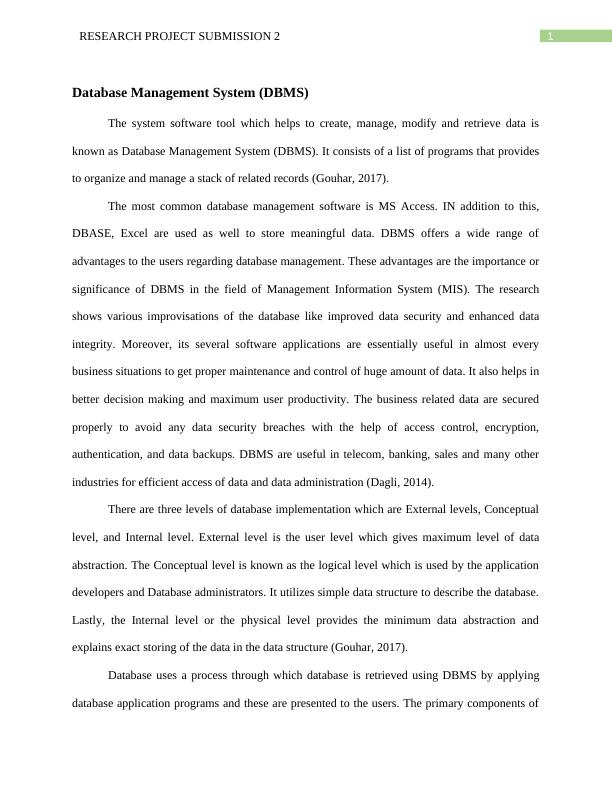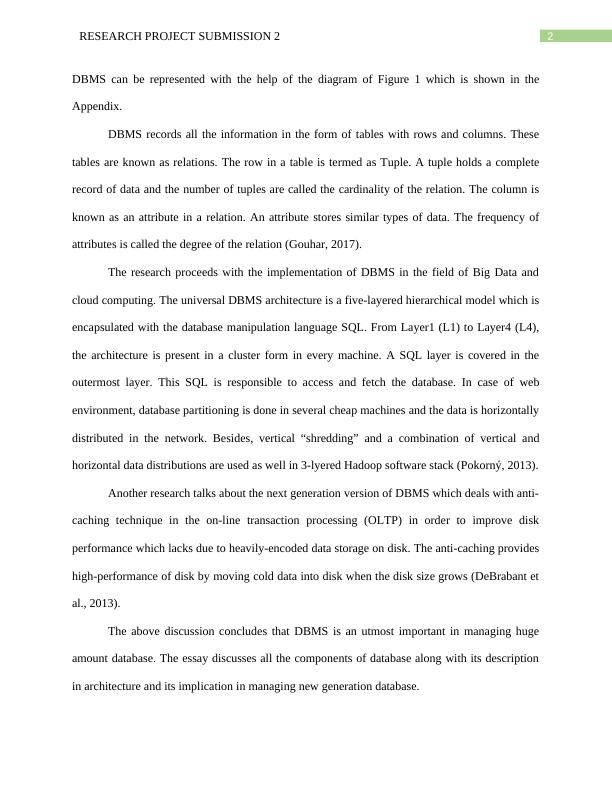Importance of Database Management System (DBMS) and Transportation Management System (TMS) in MIS
Added on 2023-06-10
8 Pages1655 Words179 Views
Running head: RESEARCH PROJECT SUBMISSION 2
5.3 Research Project Submission 2
Prem Raj Manoahaar
Introduction to Management Information Systems – MGMT 221
Embry-Riddle Aeronautical University
5.3 Research Project Submission 2
Prem Raj Manoahaar
Introduction to Management Information Systems – MGMT 221
Embry-Riddle Aeronautical University

1RESEARCH PROJECT SUBMISSION 2
Database Management System (DBMS)
The system software tool which helps to create, manage, modify and retrieve data is
known as Database Management System (DBMS). It consists of a list of programs that provides
to organize and manage a stack of related records (Gouhar, 2017).
The most common database management software is MS Access. IN addition to this,
DBASE, Excel are used as well to store meaningful data. DBMS offers a wide range of
advantages to the users regarding database management. These advantages are the importance or
significance of DBMS in the field of Management Information System (MIS). The research
shows various improvisations of the database like improved data security and enhanced data
integrity. Moreover, its several software applications are essentially useful in almost every
business situations to get proper maintenance and control of huge amount of data. It also helps in
better decision making and maximum user productivity. The business related data are secured
properly to avoid any data security breaches with the help of access control, encryption,
authentication, and data backups. DBMS are useful in telecom, banking, sales and many other
industries for efficient access of data and data administration (Dagli, 2014).
There are three levels of database implementation which are External levels, Conceptual
level, and Internal level. External level is the user level which gives maximum level of data
abstraction. The Conceptual level is known as the logical level which is used by the application
developers and Database administrators. It utilizes simple data structure to describe the database.
Lastly, the Internal level or the physical level provides the minimum data abstraction and
explains exact storing of the data in the data structure (Gouhar, 2017).
Database uses a process through which database is retrieved using DBMS by applying
database application programs and these are presented to the users. The primary components of
Database Management System (DBMS)
The system software tool which helps to create, manage, modify and retrieve data is
known as Database Management System (DBMS). It consists of a list of programs that provides
to organize and manage a stack of related records (Gouhar, 2017).
The most common database management software is MS Access. IN addition to this,
DBASE, Excel are used as well to store meaningful data. DBMS offers a wide range of
advantages to the users regarding database management. These advantages are the importance or
significance of DBMS in the field of Management Information System (MIS). The research
shows various improvisations of the database like improved data security and enhanced data
integrity. Moreover, its several software applications are essentially useful in almost every
business situations to get proper maintenance and control of huge amount of data. It also helps in
better decision making and maximum user productivity. The business related data are secured
properly to avoid any data security breaches with the help of access control, encryption,
authentication, and data backups. DBMS are useful in telecom, banking, sales and many other
industries for efficient access of data and data administration (Dagli, 2014).
There are three levels of database implementation which are External levels, Conceptual
level, and Internal level. External level is the user level which gives maximum level of data
abstraction. The Conceptual level is known as the logical level which is used by the application
developers and Database administrators. It utilizes simple data structure to describe the database.
Lastly, the Internal level or the physical level provides the minimum data abstraction and
explains exact storing of the data in the data structure (Gouhar, 2017).
Database uses a process through which database is retrieved using DBMS by applying
database application programs and these are presented to the users. The primary components of

2RESEARCH PROJECT SUBMISSION 2
DBMS can be represented with the help of the diagram of Figure 1 which is shown in the
Appendix.
DBMS records all the information in the form of tables with rows and columns. These
tables are known as relations. The row in a table is termed as Tuple. A tuple holds a complete
record of data and the number of tuples are called the cardinality of the relation. The column is
known as an attribute in a relation. An attribute stores similar types of data. The frequency of
attributes is called the degree of the relation (Gouhar, 2017).
The research proceeds with the implementation of DBMS in the field of Big Data and
cloud computing. The universal DBMS architecture is a five-layered hierarchical model which is
encapsulated with the database manipulation language SQL. From Layer1 (L1) to Layer4 (L4),
the architecture is present in a cluster form in every machine. A SQL layer is covered in the
outermost layer. This SQL is responsible to access and fetch the database. In case of web
environment, database partitioning is done in several cheap machines and the data is horizontally
distributed in the network. Besides, vertical “shredding” and a combination of vertical and
horizontal data distributions are used as well in 3-lyered Hadoop software stack (Pokorný, 2013).
Another research talks about the next generation version of DBMS which deals with anti-
caching technique in the on-line transaction processing (OLTP) in order to improve disk
performance which lacks due to heavily-encoded data storage on disk. The anti-caching provides
high-performance of disk by moving cold data into disk when the disk size grows (DeBrabant et
al., 2013).
The above discussion concludes that DBMS is an utmost important in managing huge
amount database. The essay discusses all the components of database along with its description
in architecture and its implication in managing new generation database.
DBMS can be represented with the help of the diagram of Figure 1 which is shown in the
Appendix.
DBMS records all the information in the form of tables with rows and columns. These
tables are known as relations. The row in a table is termed as Tuple. A tuple holds a complete
record of data and the number of tuples are called the cardinality of the relation. The column is
known as an attribute in a relation. An attribute stores similar types of data. The frequency of
attributes is called the degree of the relation (Gouhar, 2017).
The research proceeds with the implementation of DBMS in the field of Big Data and
cloud computing. The universal DBMS architecture is a five-layered hierarchical model which is
encapsulated with the database manipulation language SQL. From Layer1 (L1) to Layer4 (L4),
the architecture is present in a cluster form in every machine. A SQL layer is covered in the
outermost layer. This SQL is responsible to access and fetch the database. In case of web
environment, database partitioning is done in several cheap machines and the data is horizontally
distributed in the network. Besides, vertical “shredding” and a combination of vertical and
horizontal data distributions are used as well in 3-lyered Hadoop software stack (Pokorný, 2013).
Another research talks about the next generation version of DBMS which deals with anti-
caching technique in the on-line transaction processing (OLTP) in order to improve disk
performance which lacks due to heavily-encoded data storage on disk. The anti-caching provides
high-performance of disk by moving cold data into disk when the disk size grows (DeBrabant et
al., 2013).
The above discussion concludes that DBMS is an utmost important in managing huge
amount database. The essay discusses all the components of database along with its description
in architecture and its implication in managing new generation database.

End of preview
Want to access all the pages? Upload your documents or become a member.
Related Documents
Introduction to Databases: Database Design and Developmentlg...
|15
|2004
|170
Database Design and Developmentlg...
|23
|3990
|151
Database Management Systemlg...
|17
|2003
|258
Database Management System | Assignment Samplelg...
|16
|2118
|39
Collection of Logically Related Data - Deskliblg...
|6
|563
|99
Database Management System and Three-Schema Architecturelg...
|8
|2517
|408
